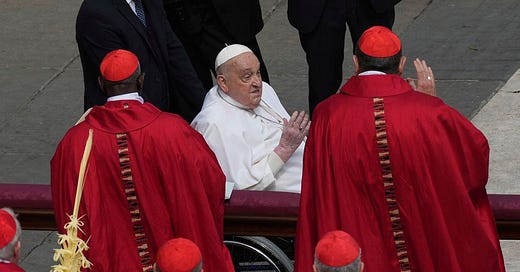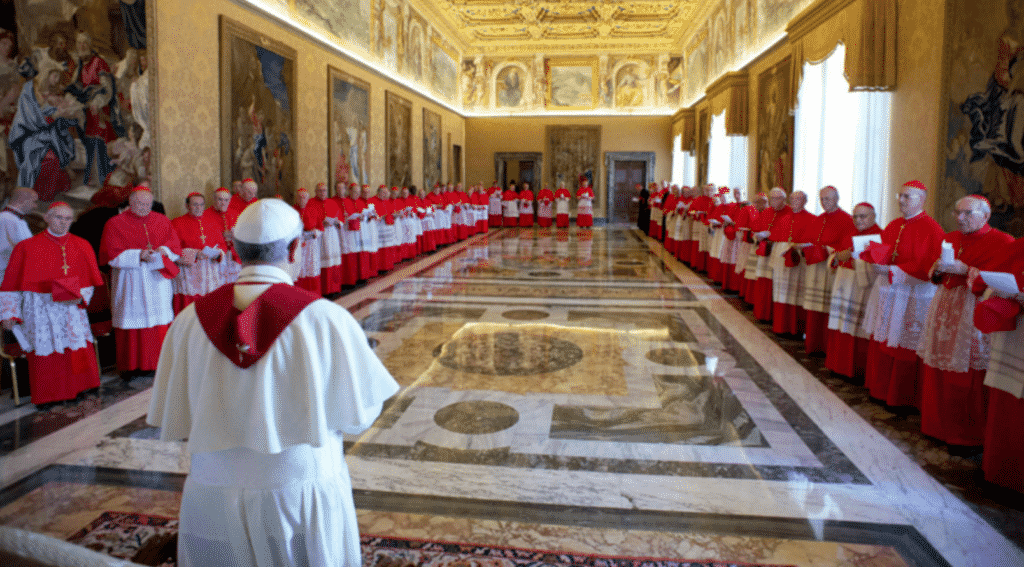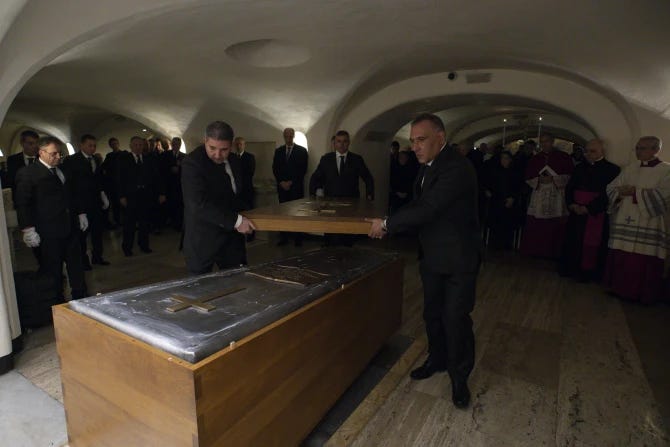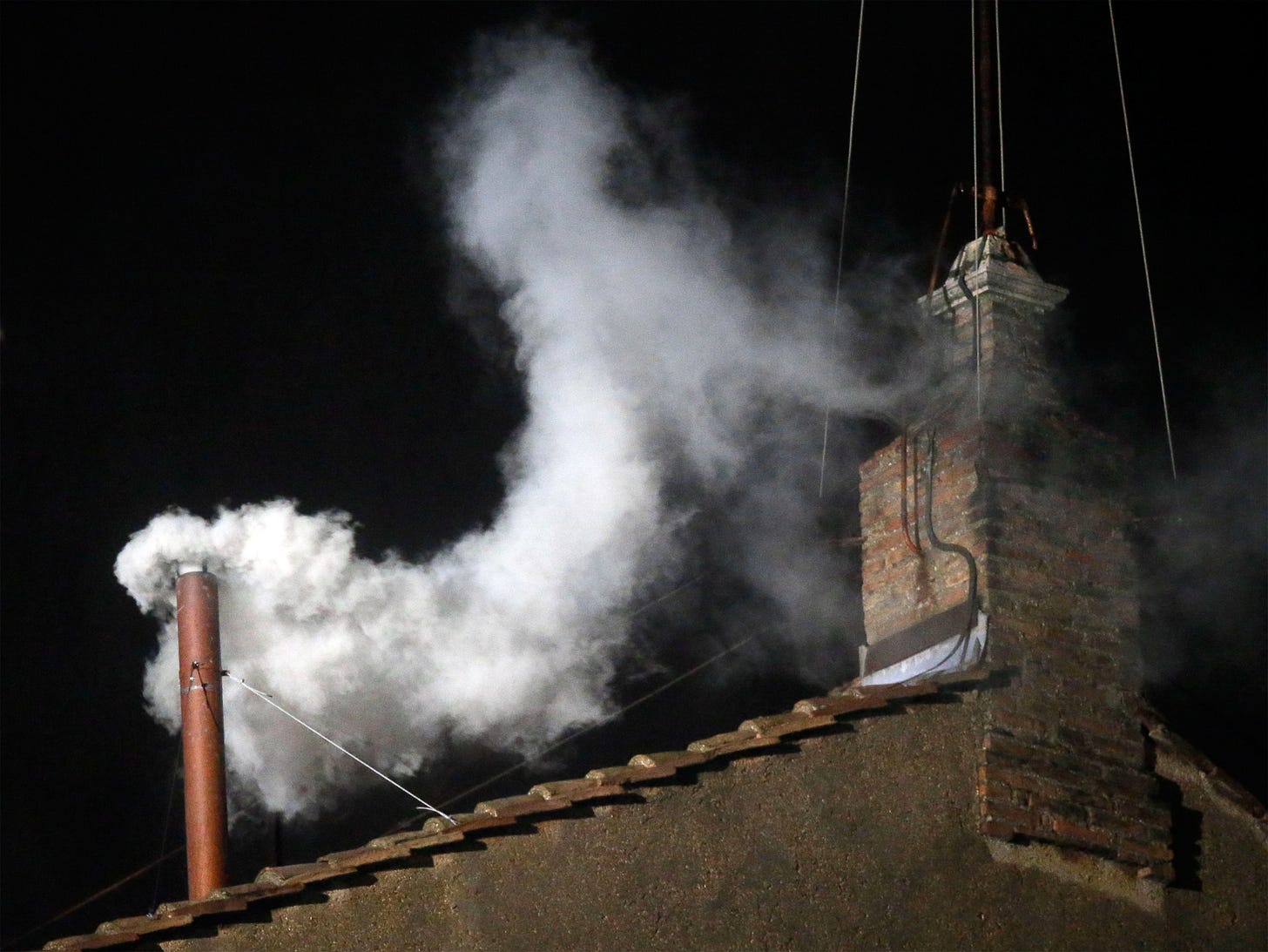The death of the Supreme Pontiff always sends a quiet thunderclap through the soul of the Church. Pope Francis, the 266th successor of St. Peter, has died. And with his passing, the Barque of Peter sails without a visible helmsman—for now. This sacred interlude is known as the interregnum, or sede vacante (“the seat being vacant”), and it marks one of the most solemn and spiritually weighty moments in the life of the Catholic Church. In this period, heaven and earth hold their breath. The Church mourns the passing of her spiritual father, even as she prepares to welcome a new one.
Let us walk together, then, through the sacred events that unfold from the moment a pope breathes his last until the cardinals gather under Michelangelo’s frescoes to elect the next Vicar of Christ.
“The Pope is Dead”: The Church Acknowledges the Passing of the Vicar of Christ
As soon as the pope is confirmed deceased, the Church enters a solemn rhythm of mourning. According to tradition, the Camerlengo—currently Cardinal Kevin Farrell—holds the responsibility of verifying the pope’s death.
Once death is established, the Camerlengo retrieves the Pope’s Fisherman’s Ring—the signet ring used to authenticate papal documents—and breaks it before witnesses, symbolizing the end of the pontificate and preventing its misuse.
It is a moment charged with theological gravity. The visible shepherd of the visible Church has departed, and now the Church awaits the election of another. St. Ambrose once wrote, “Ubi Petrus, ibi Ecclesia”—where Peter is, there is the Church. And until Peter’s successor is chosen, the sede vacante is a liminal space of prayer, expectation, and spiritual vigilance.
Sede Vacante: No Pope, but the Church Remains
With the Pope’s death, the sede vacante formally begins. The Apostolic Constitution Universi Dominici Gregis (1996), promulgated by Pope St. John Paul II and later modified by Benedict XVI, governs this interregnum.
During this time, all heads of Roman dicasteries (with the exception of the Camerlengo, the Major Penitentiary, and the Vicar of Rome) cease their functions. The College of Cardinals assumes the governance of the Church in limited form—only matters of ordinary administration and those that cannot be delayed are permitted. They cannot introduce doctrinal changes, make episcopal appointments, or enact reforms. The Church remains, not as an orphan, but as a bride in mourning, guarded by the College until the Bridegroom’s vicar is chosen anew.
Liturgically, the Vatican enters a period of mourning, usually nine days of novemdiales Masses for the repose of the pope’s soul. Black vestments are worn. Bells toll. Flags fly at half-staff. And millions of Catholics throughout the world lift their hearts in prayer.
The late pope’s body is embalmed and laid in state, traditionally in St. Peter’s Basilica. Francis has requested to be buried in St. Mary Major Basilica. Throngs of faithful come to pay their respects—kneeling, weeping, some in contemplative silence. It is the Church’s way of saying: “We have not lost our father; we commend him to the Father.”
Papal Funeral: A Liturgy of Hope and Tradition
The funeral Mass of the pope is one of the most watched and solemnly celebrated events in the Catholic world. Traditionally held in St. Peter’s Square, it is usually presided over by the Dean of the College of Cardinals. During the rites, the pope’s Rogito—a brief biographical parchment scroll describing his life, his works, and significant acts of his pontificate—is placed within a cypress coffin, along with medals minted during his reign and a red velvet pouch containing various papal coins.
The body is placed in three nested coffins—cypress, zinc, and oak—before being interred in the crypt beneath St. Peter’s Basilica. The triple coffin symbolizes the honor of the deceased, the protection of the body, and the continuity of tradition. Francis has requested just the cypress coffin for his burial in a visible expression of simplicity. The Latin chants, the incense, the tears, and the hope—these elements all proclaim: the Church does not despair, for Christ remains her head.
Preparation for the Conclave: The Guardians of the Keys Assemble
Once the pope’s funeral has taken place, preparations for the conclave commence in earnest. The word conclave itself comes from the Latin cum clave, meaning “with a key”—referring to the locked chamber where the cardinals are sequestered to deliberate and elect the next pope.
All cardinals under the age of 80 are eligible to vote. They are summoned to Rome, if not already present, and take up residence in the Domus Sanctae Marthae. During the General Congregations of cardinals, they discuss the needs of the Church and prepare for the voting process.
It is during these days that speculation runs rampant—lists of papabili (those considered “pope-able”) are circulated, and the secular media swarms Vatican City. But within the Church, the emphasis is not on politics or personality. It is prayer, fasting, and discernment that carry the day. As Joseph Ratzinger once declared, “We are not a political organization, we are the Church of Jesus Christ.”
Before entering the Sistine Chapel, the cardinals participate in a Mass Pro Eligendo Romano Pontifice—for the election of the Roman Pontiff. The Church asks the Holy Spirit to descend with clarity and power, as in the Upper Room at Pentecost. The cardinals then take a solemn oath to maintain secrecy, fidelity, and to elect only the one they believe God has chosen.
Sacred Traditions and Symbols: Cloistered with the Holy Spirit
As the cardinals process into the Sistine Chapel beneath Michelangelo’s awe-inspiring Last Judgment, the gravity of their task is unmistakable. Once inside, the famous command is spoken: “Extra omnes!”—Everyone out!—signaling the sealing of the conclave.
Every detail speaks to the holiness of the moment. The ballots are cast by hand, each cardinal writing the name of his chosen candidate and folding the ballot twice before placing it on a paten and sliding it into a chalice. The votes are then counted aloud, and if a pope is not elected, the ballots are burned with chemicals to produce black smoke—fumata nera. When a pope is elected, white smoke—fumata bianca—signals the joyous news to the world: Habemus Papam!
But before that white smoke rises, we live in the sacred tension of the unknown. This is the time for the faithful to cry out to heaven in spiritual solidarity with the Church’s shepherds.
A Time for Grief, Prayer, and Hope
The death of Pope Francis reminds us that the Church is built on mortal men but is ever sustained by immortal grace. The Church is pure because her bridegroom is pure. And the Church is flawed only inasmuch as her members are flawed. We mourn grieve, yes—but not as those without hope (cf. 1 Thessalonians 4:13). The blood of Peter still courses through the veins of the Church, and the voice of the Risen Lord still speaks: “Feed my sheep” (John 21:17). The Petrine Office remains, and Christ, who promised the gates of hell shall not prevail (cf. Matthew 16:18), will once again call a man by name to “strengthen his brothers” (cf. Luke 22:32).
Let us now, with filial love and Christian confidence, commend the soul of Pope Francis to the mercy of God. We thank him for his service to the Church and pray: “Eternal rest grant unto him, O Lord, and let perpetual light shine upon him.” May he rest in peace.
And let us pray for the College of Cardinals—that they may be docile and obedient to the guidance of the Holy Spirit and elect a holy man after God’s own heart. A man who will uphold the fullness of truth, proclaim the Gospel with courage, help the faithful stand firm against the lies of a post-christian age, and be a true father to the universal Church. A man ready to take up the keys of Peter, and bind and loose with truth, wisdom, and love.
In this sacred in-between, let the Church rise up in fasting and intercession. The world watches, but more importantly, heaven watches.
Come, Holy Spirit. Come.












